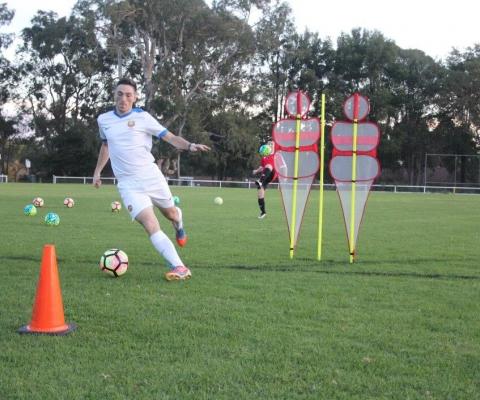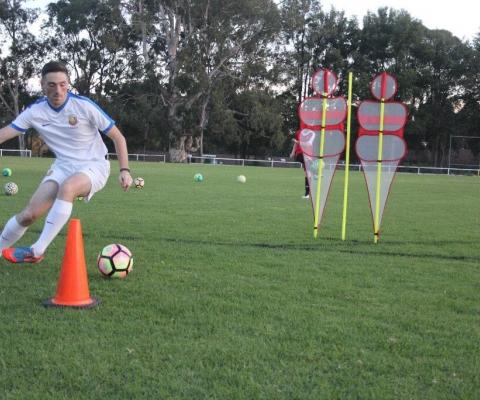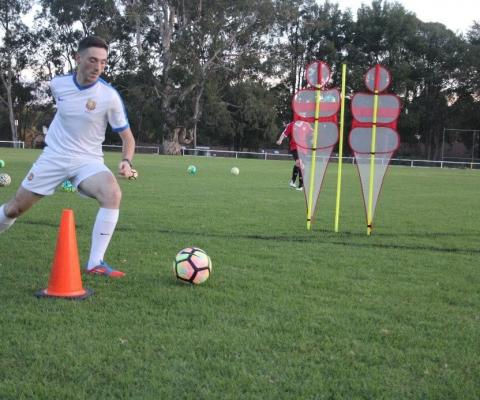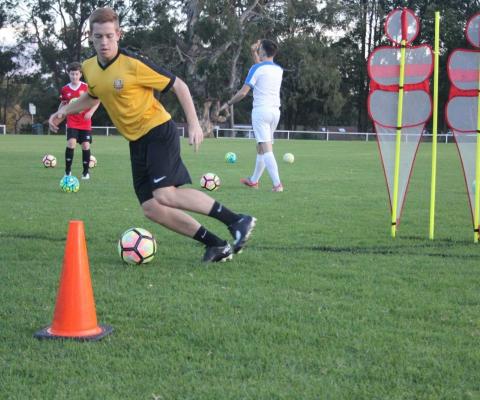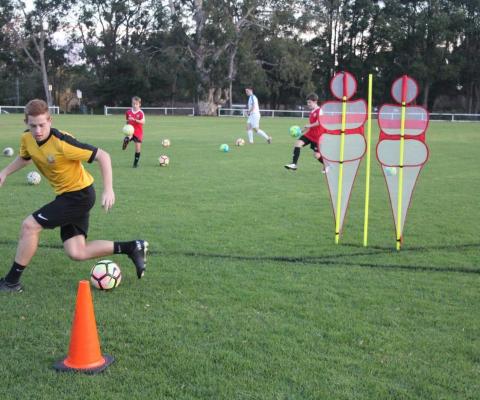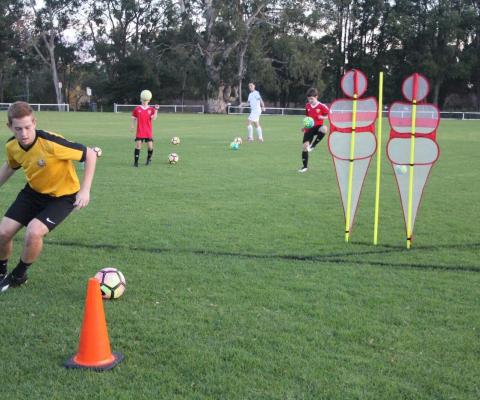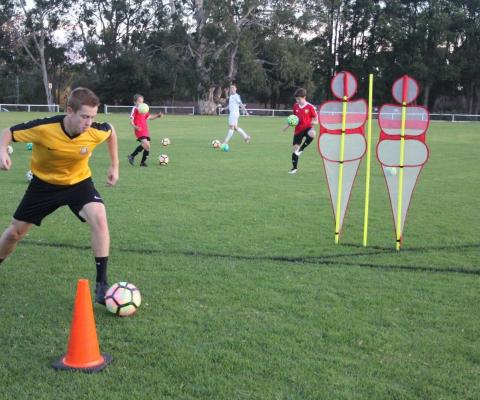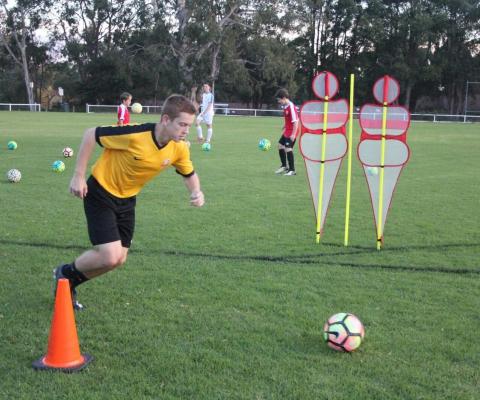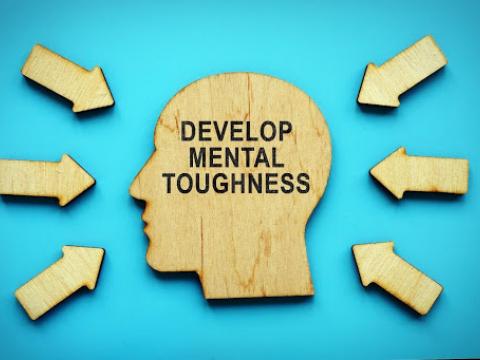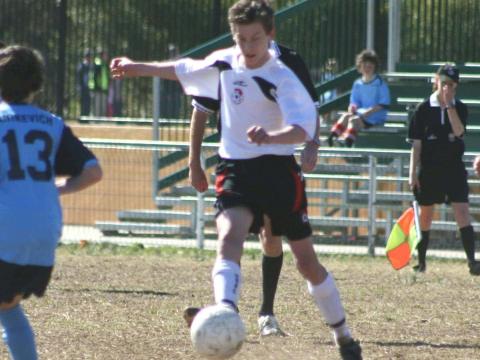Written by Michael Robson
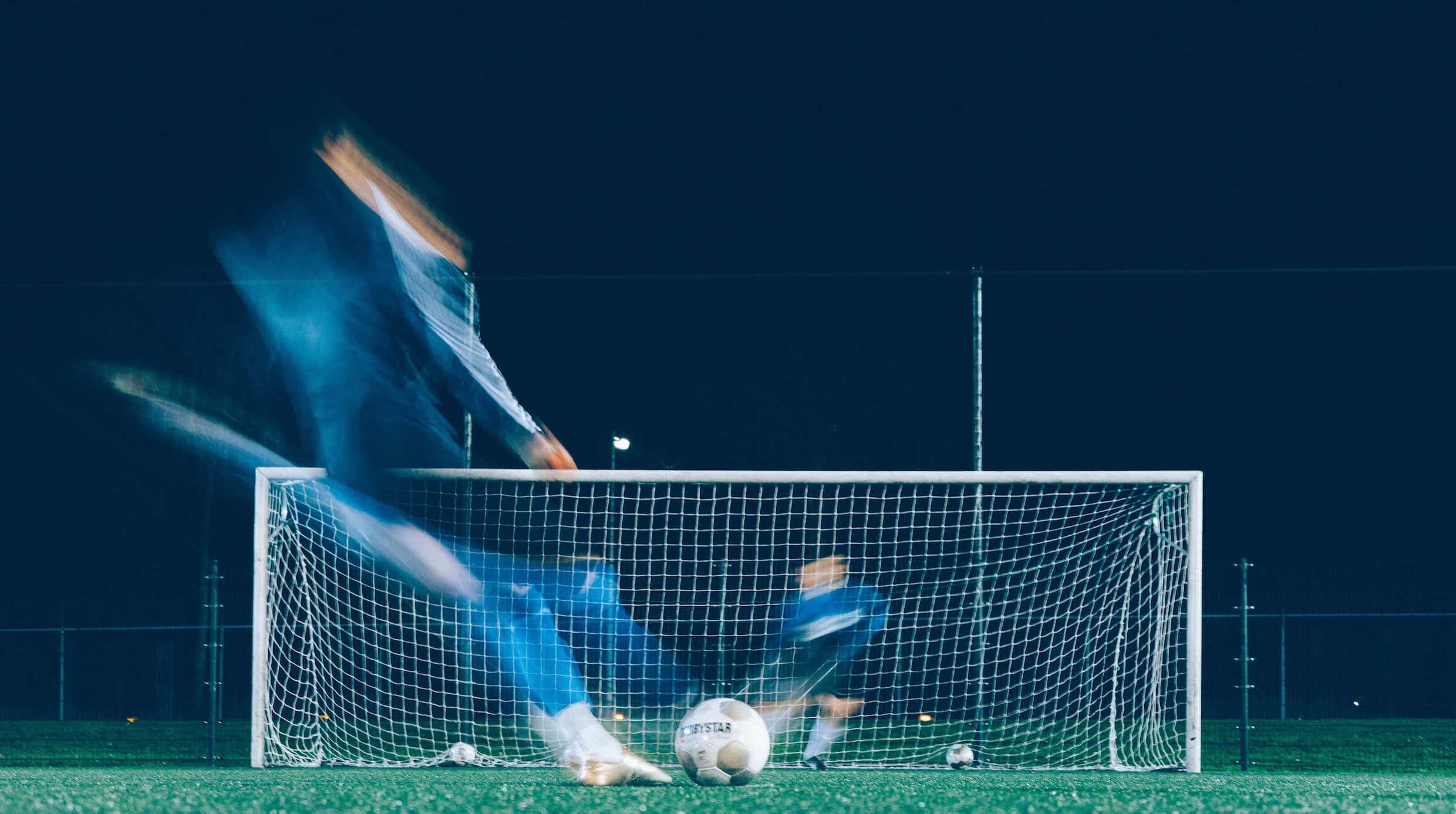
Image Source:https://historyofsoccer.info/forwards-in-soccer
- Let’s start with the Definition of a Football Striker
- So how do you become a better soccer striker?
- What is the right football attitude for a striker?
- How can you improve your attitude as a soccer striker?
- Purposeful Practice
- So how does a striker practice?
- Touch
- So how do you develop football touch?
- Skill Development
- Shooting accuracy
- Visualisation
- Game preparation
- The Observer
- The Thinker
- The Worker
- Confidence
- How do you build and most importantly protect your confidence?
- Conclusion
Let’s start with the Definition of a Football Striker
A soccer striker is the primary goal scorer in a team. They are creative, hardworking and generally very confident. They accept that they are going to make mistakes and this does not bother them. They are mentally tough. They are intelligent, quick thinking and action orientated. They are observers constantly looking for weaknesses in the opposition. They have a number of highly practiced skills that they consistently execute effectively. They have one signature move that they can execute nearly perfectly every time. They crave success - they score goals frequently.
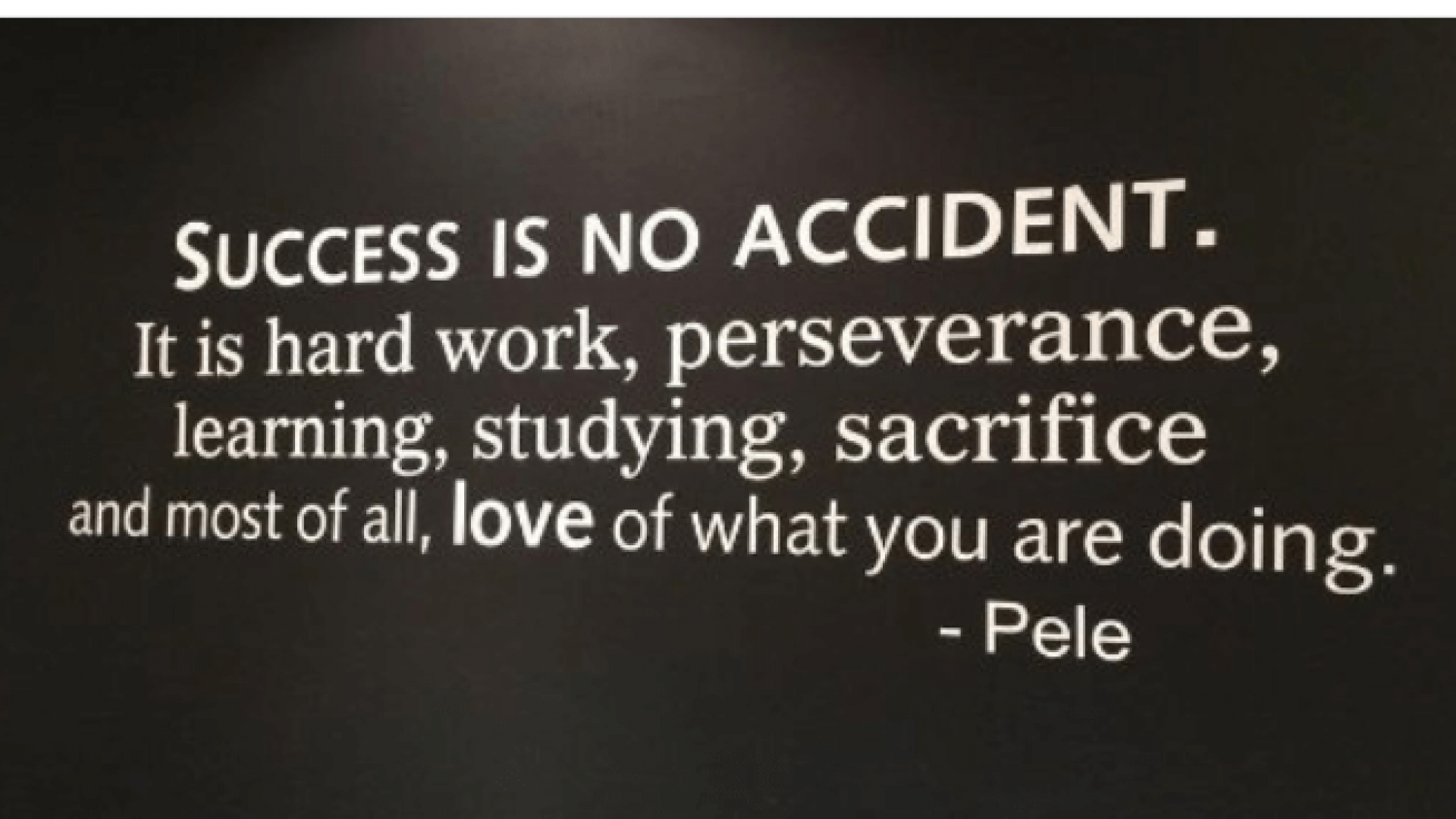
So how do you become a better soccer striker?
We strongly agree with Pele’s quote. To become a better soccer striker will require hard work and perseverance. It will require an attitude of constant learning and studying. To be successful, lots of sacrifices will need to be made by the player and their family but most importantly you must love the game and what you are doing – if you lose the love you will lose the desire.

To start to become a better football striker, you must have the right attitude.
What is the right football attitude for a striker?
A player’s road to success begins with their attitude. The attitude towards the coach, fellow teammates, training sessions, as well as composure on the field, are some of the attitude characteristics that make a great striker. Consider the following points and think about how your attitude in these areas could improve:
- Positive attitude to winning yet maintaining a positive and supportive attitude towards teammates even after a loss.
- Being respectful to the opposition, whether it’s players, team managers or coaches.
- Supportive and helpful attitude, a nice person to be around, with a bit of humour but not over the top.
- Humility. Football is a team game; you must understand there are more players in the team than just you.
- Be open to criticism and learn from it – don’t take it as a negative, see it as an opportunity to improve, this mental approach will protect your self confidence.
- Be tough. Don’t turn away from tackles and make sure you are not a player that gets injured excessively – coaches don’t like that type of player!
- Show your presence on the field. This is not an excuse for unwarranted aggression. This is pivotal in a player’s attitude. Presence and aggression are very different if you are getting a lot of yellow cards you are being too aggressive.
- All strikers need a bit of arrogance. They believe in themselves. They believe that they can and will score nearly every game. This is not to contradict humility; these elements can coexist. As a striker, arrogance must remain an internal motivator and confidence booster, don’t let it become a negative of your game. The balance is fine, which is why this is an important point.
- Sportsmanship is important, it will drive how you play – fair but solid. A sportsmanlike attitude will help control excessive aggression.
How can you improve your attitude as a soccer striker?
Firstly, mental toughness and self-talk are arguably the most important traits. See the article on mental toughness.
As a striker, YOU must control your self-talk. Do not allow your self-talk to be destructive or critical – it must always be positive or at least neutral – i.e. “I will get it next time.”
Another point is visualisation - how to prepare for peak performance, which I discuss in detail later.
Overall, friendly and caring towards others, this attitude is a “must-have” skill. For further reading: “How to Win Friends and Influence People” by Dale Carnegie or for a quick summary see this blog article.
Purposeful Practice
We have all heard the old saying that 10,000 hours of practice is required to make you an expert, which to an extent is true. However, it is what you do within those 10,000 hours that really makes the difference, as practice without purpose is almost a waste of time.
A perfect example of this is Tim Cahill, who, as a youngster, was told he was too short to make it as a football player. Now retiring at the age of 39 and looking back at his career, some of the goals Tim scored with his head were outstanding. Why? Because Tim had a purpose behind his training. In his autobiography “Tim Cahill Legacy”, Tim states “With the Marrickville Red Devils, my vision, technique and ability to head the ball made me a stand out, despite being a year younger than anyone else in the squad. And the more I scored with my head, the more I would train and train at heading. Some weeks, I spent hours just trying to perfect the angling and generate more power with my contact”. This was purposeful practice.
Without any doubt, a football striker MUST practice but not just any practice, it must be purposeful and deliberate. Absolutely nothing can replace practice. Practice makes perfect – not quite, but deliberate practice makes a substance in the brain called Myelin. Developing Myelin means that you can execute the move far better so we say "Practice makes Myelin and Myelin makes permanent. For more on this topic see our blog 6-reasons-why-strikers-needs-specialist-training - point 6.
So how does a striker practice?
For football skill development, start small – work on one thing. Go very slow to get the technique right. Then increase speed, and keep pushing yourself to get faster and faster, but it must still be executed perfectly.
Set yourself goals. Aim for 20 in a row, done perfectly at maximum speed – when you can get to that level, you have a skill that is permanent. If you only get to 15, then start again from one. This will help build mental toughness while practicing with purpose. Watch your self-talk – do not bash yourself up. “I am working towards being better” - must be your mantra.
Touch
The importance of touch to a striker cannot be emphasised enough. Touch is a critical skill especially when a striker finds themselves in a tight situation with all odds against them. It is in these situations that a striker’s skill in touch is the difference in a successful attack or its downfall.
In developing touch, there are many parts of the body that a striker can utilise to their advantage. However, as explained above, this does not happen overnight, it comes from lots of purposeful practice.
From simply using different angles on your feet, to first time volleys, shoulders, thigh or even your back (check out 1.34 to 1.43 sec), Ronaldo uses his back!
The limit is your imagination and the more creative the touch, the high chances of beating that unsuspecting defender!
So how do you develop football touch?
You guessed it – practice. We recommend a 20-minute twice weekly session (as a minimum) just on touch. Ideally, you would work with a friend or parent feeding you a ball, however, a brick wall can do but it will require more dedication. Receive and return the ball about 10 times on each foot – alternating between feet. You must not remain static, moving off the ball is integral to developing a good touch. Use the inside of the foot, laces, outside of the foot, thigh, chest, shoulder and head.
Juggling is also a great way to develop touch, but again you must involve movement. Mark out 6 cones and place them 5 metres apart from each other in a straight line. Now see if you can juggle along next to the cones, when you get to the 30-metre mark, kick the ball over your head, turn around and head back to the starting line while still juggling. Once you achieve 60 metres, increase the speed to a jogging pace. Try this activity with the left foot only, then the right foot only, and finally with both feet. Add in your thighs, shoulders and head if you can, but the point of the drill is to improve the touch with your feet, so use the others only if you need to. Use our Golden Boot Striker Academy records as the benchmark to beat:
- Right Foot – 150m – Pat Rosato
- Left Foot – 130m – Eli Salisbury
- Both Feet Combined – 290m – Eli Salisbury
Another simple, yet effective, drill is what we call the “soft foot” technique. Soft Foot is when a player receives the ball from a high kick, and by using a soft foot, controls the ball to stop directly at their feet without the ball rolling away from them. The trick is to make the foot very loose and relax the angle so the foot is limp. Throw the ball high into the air, and while the foot is limp, receive the ball so it nearly stays on your foot. If the ball bounces away from your foot, your ankle is still locked. Practice using both feet.
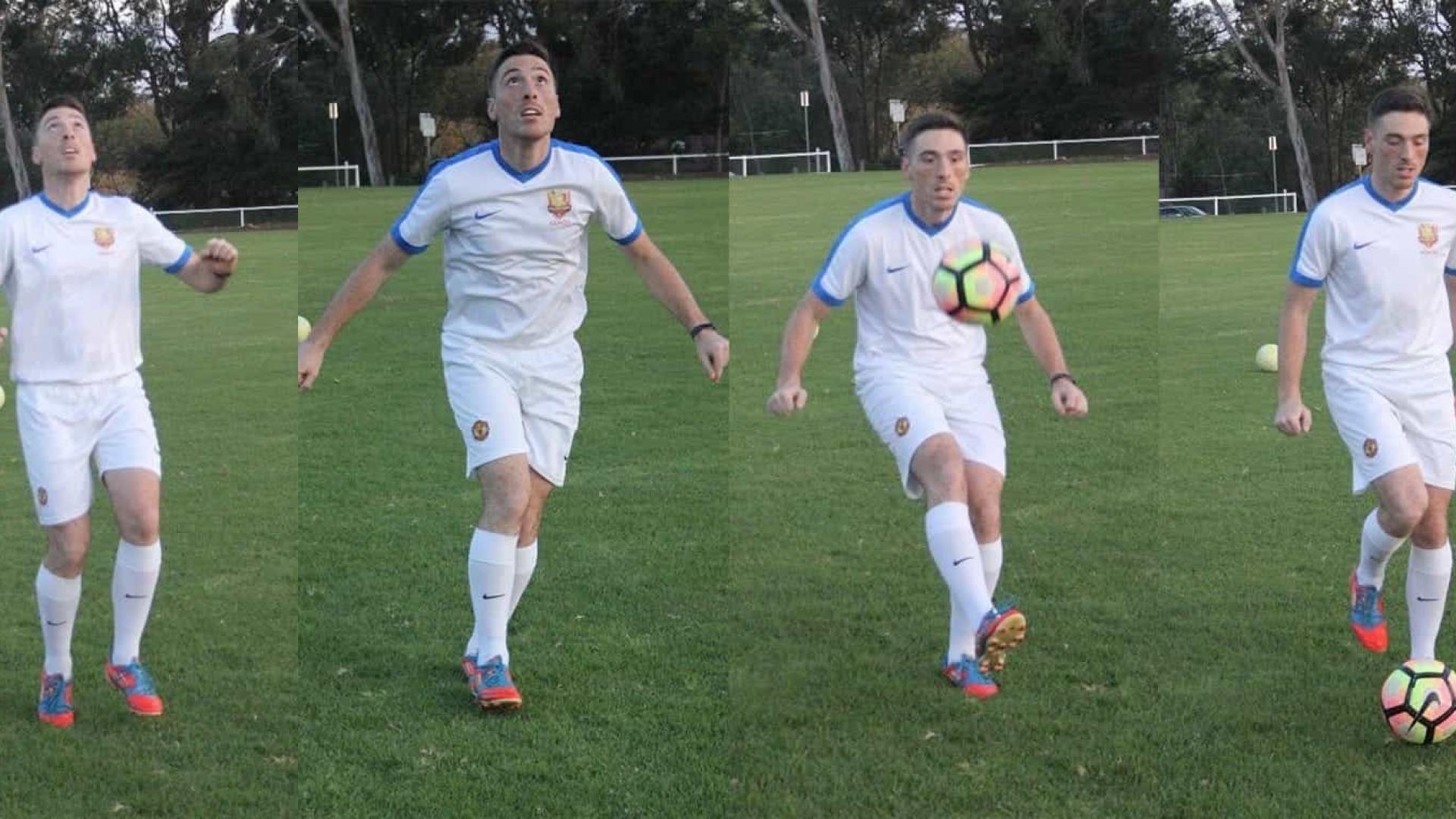
Using a wall kick the ball hard and receive it back. Again, soft foot and cushion the ball when receiving.
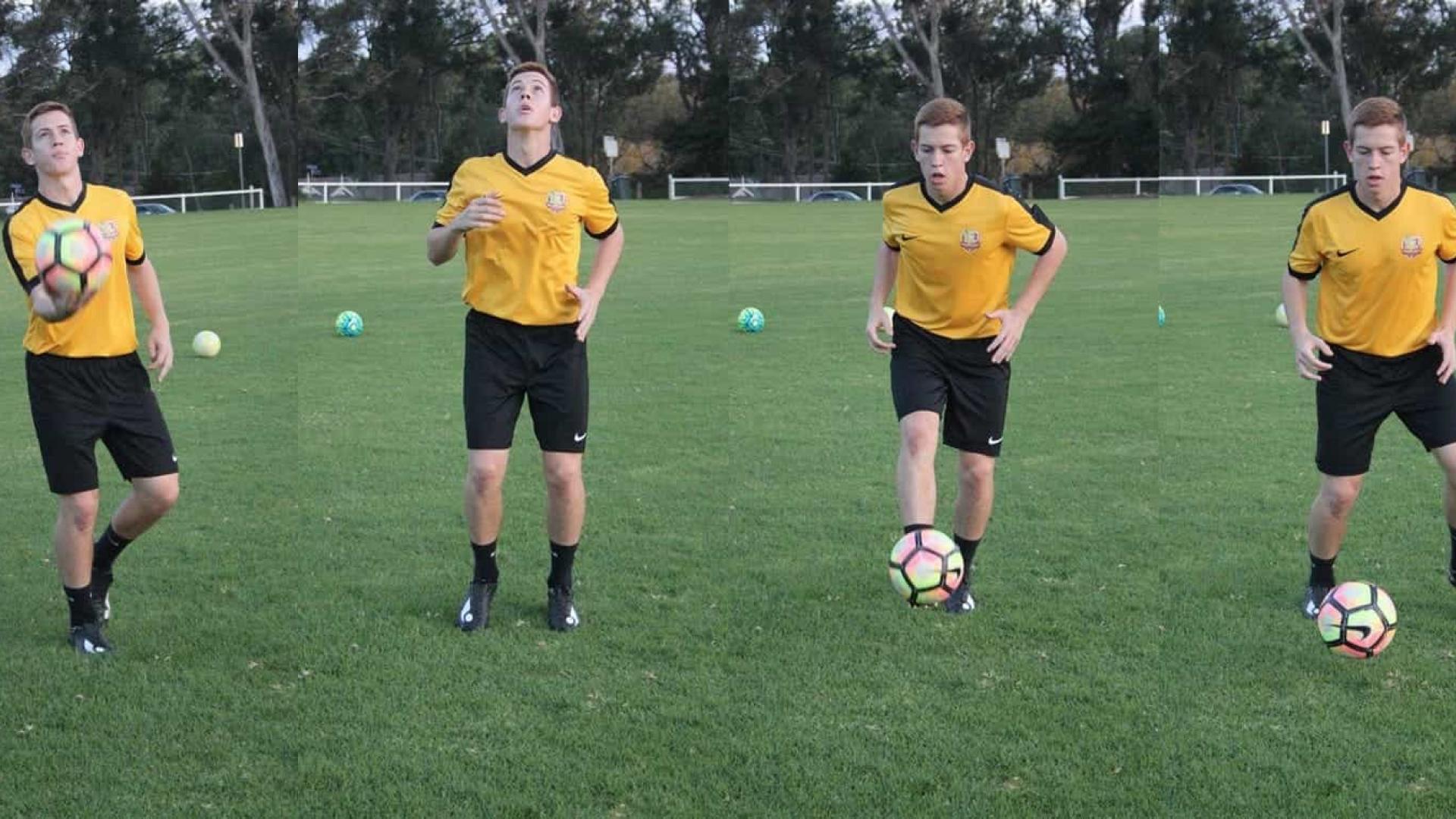
Skill Development
Skill development is the ability to do a move at speed and execute nearly perfectly, most of the time. It is impossible to execute a perfect move every time so if you fail on an occasion do not put yourself down.
No-one can do every move perfectly. The best players in the world have their signature moves. Rolando does the Rolando Chop which in a parallel hook. Messi is very good at the inside cut and the double outside cut and over the years there have been many great players that have perfected a move – Rivelino - the step-over, the Maradona spinner, the Beckenbauer and more recently the Courtino signature move.
Choose a move you like and are comfortable with. Take your time to decide. We use 36 different moves in our football striker academy and I am sure there are many more. Decide to make one your signature move. Look up the move on YouTube and study the execution of the move. During your research see if the move can be broken into smaller parts e.g. the step-over has four parts –
1. The step-over of the ball with the foot
2. The placement of the foot on the ground just to the side of the ball, so the foot is ready to take the ball away in the next part of the move,
3. The body movement i.e. the movement of the top half of the body which is important in selling the move and
4. Then using the outside of the foot an explosive (fast) take away of the ball.
Perfect it by practising the move very slowly at first. Make sure you do each element of the move perfectly i.e. get the technique right first – before doing the move in front of an obstacle – use the move to get around the obstacle. Practice using both feet. Then increase the speed of executing the move, then increase the speed of running while executing the move.
Then keep on practising the move every week, because if you don’t use it, you lose it.
Below is a list of some of the more common skill development moves.
| Scissors | Inside Cut | Chip |
| Step-over | Outside Cut | Scoop |
| Maradona Spinner | Double outside cut | Dummy Kick |
| Feint | Parallel Hook / Rolando Chop | Beckenbauer |
| Scorpion | Reverse Hook | Slider |
I like the was that Lionel Messi describes purposeful practise -
Shooting accuracy
For shooting accuracy. Set up a target – bottom left-hand corner of a goal. Start in front of the target area and back 5 metres from the target – 5 shots left foot, 5 shots right foot. Score yourself. Then move 2 metres to the right start again, 2 metres to the left. The move back another 5 metres – same process.
Your practice schedule should look something like this table
| Target | Shot location | Shot Distance | Score left Foot | Score Right foot |
|---|---|---|---|---|
| Bottom left corner | Center | 5M | 3 | 5 |
| Bottom left corner | 2 M Left | 5M | ||
| Bottom left corner | 2 M Right | 5M | ||
| Bottom left corner | Center | 10M | ||
| Bottom left corner | 2 M Left | 10M | ||
| Bottom left corner | 2 M Right | 10M | ||
| Bottom left corner | Center | 15m | ||
| Bottom left corner | 2 M Left | 15m | ||
| Bottom left corner | 2 M Right | 15m | ||
| Bottom left corner | Center | 20M | ||
| Bottom left corner | 2 M Left | 20M | ||
| Bottom left corner | 2 M Right | 20M | ||
| Bottom left corner | Center | 25M | ||
| Bottom left corner | 2 M Left | 25M | ||
| Bottom left corner | 2 M Right | 25M | ||
| Btm Right corner | Center | 5M | ||
| Btm Right corner | 2 M Left | 5M | ||
| Btm Right corner | 2 M Right | 5M | ||
| Btm Right corner | Center | 10M | ||
| Btm Right corner | 2 M Left | 10M | ||
| Btm Right corner | 2 M Right | 10M | ||
| Btm Right corner | Center | 15M | ||
| Btm Right corner | 2 M Left | 15M | ||
| Btm Right corner | 2 M Right | 15M | ||
| Btm Right corner | Center | 20M | ||
| Btm Right corner | 2 M Left | 20M | ||
| Btm Right corner | 2 M Right | 20M | ||
| Btm Right corner | Center | 25M | ||
| Btm Right corner | 2 M Left | 25M | ||
| Btm Right corner | 2 M Right | 25M |
I did say a striker needs to practice!
Your score will give you a guide to areas that need to be improved. The above is a basic start. After you have got to the stage where you are consistently scoring 4 and 5 on both feet you can add a move or skill before shooting.
Visualisation
Visualisation is a very powerful tool to help you become a better striker. Visualisation taps into the mental side of being a striker. It is a mental rehearsal of your playing at peak performance. I have visualisation effectively many times and strongly recommend it as part of any plan to become a better soccer striker.
“I lie in bed the night before the game and visualise myself scoring goals or doing well,” Wayne Rooney once revealed. “You're trying to put yourself in that moment and trying to prepare yourself, to have a 'memory' before the game. I don't know if you'd call it visualising or dreaming, but I've always done it, my whole life.”
For more background see this great article “The power of positive visualisation” by Roy Skillen.
Then review this five-step process on how to do visualisation by Matt Neason.
Game preparation
Gameday is full of nerves, excitement and anticipation. It is very important to get your body and mind in the right place for the start of the game. Consistency in high-quality performance requires consistency in a high-quality approach. Approach each game in the same manner (as if it is a grand final). Prepare your gear early – have a checklist so you don’t forget something. Make sure your boots are clean – attention to detail starts with your boots. First-aid blister bandages, bandaids, puffer if you need it etc. Plenty of water and start hydrating the day before the game to help with cramp.
Then there is the mental side. Build your confidence with your Personal Hero Portfolio (see more in the confidence section below).
We have created a list of mental affirmations that will help with your mental preparation. This will be available soon.
The Observer
A striker must be an observer this video shows what can be achieved. This is what we call “Hide and Steal”. Watch what the player does at the 17-second mark. He had obviously planned the move. The plan would have been hatched from his observation of what the keeper did earlier in the game.
We have identified 21 different opportunities based on observations from just the keeper. To get you started we have listed five below:
|
# |
Keeper action |
Your action |
|
1 |
Keeper off their line |
Long distance shot |
|
2 |
Pass back from defender – first touch is poor |
Apply pressure. The keeper will become more nervous |
|
3 |
The keeper drops the ball |
Follow in every time looking for the drop ball |
|
4 |
Keeper does not dive |
Make sure you shoot down low into the goal corners. |
|
5 |
Does keeper play out long balls or short balls? |
Look for the playing pattern. Be ready to intercept
|
Be sure to come back and revisit this blog as we will be shortly releasing our Striker Observations Infographic.
To observe the keepers reactions, you must put some balls to the keeper so in the first 10 minutes you should be having shot after shot, even long distance shots that are unsuccessful will provide you with information that might win your team the game later. And you never know one of those shots might just come off.
The Thinker
We contend the smartest football players are strikers. A striker has to be thinking all of the time about how they are going to beat a defender – 1 on 1, runs, moves, defensive position, goalkeeper weaknesses, pressing opportunities.
The decisions are endless and these decisions must be made quickly and then actioned or executed. The FFA Curriculum calls this process PDE - perception, decision and execution.
So how does a striker develop decision making and thinking?
The development comes from experience but the experience can be built in multiple ways, from playing in a game to watching a game and doing research and analysis of a game.
When you’re watching a game on a TV that has video replay – go back a few minutes and observe the striker's decision-making process.
A thinker exercise
Using a writing pad and pen, set yourself down in front of the TV and watch a game and while watching ask yourself these questions:
- Which defender is weaker?
- Which side is the best side to attack?
- Who is the slowest defender, could I beat him for speed?
- What are the strength and weaknesses of the keeper?
- Are the central defenders a good combination?
- What about the wing-back, which is the weakest or slowest?
- Which defender has the best skills with the ball - He is not the one to target for closing down?
- Does anyone back pass frequently?
- How does the keeper play out – do they play the same way each time?
And there are a lot more questions you should be considering!
The Worker
In the last few years, the world game has changed in two key areas for strikers.
- Mobility runs. A striker is required to do more runs. It is important that the runs occur to break down the defence and to get behind the defence. The manner of the run, parallel, so you don’t get offside means that the runs require more effort.
- Attackers are now expected to share defensive work. By defensive work, we mean closing down a defender and put pressure on all players. The work rate of a striker is now a major selection criterion for a coach. I would suggest that Roberto Firmino’s work rate is why he is chosen over Daniel Sturridge. You will often see Firmino tracking back well into Liverpool’s final third.
The ability to do more work is directly related to your fitness. A striker must be fit, must be able to do more running and defence than ever before. And that rests with the individual both pre-season and during the season. We contend that pre-season fitness is far more important for a striker than any other player. If you are super fit at the start of the season then you will have an edge while the other players get match fit. Extra energy and fitness are a massive benefit in getting more game time.
If you put in the effort the coach will notice and you will get more time on the field.
Confidence
Being a confident football striker gives you the ability to think you can do something and the courage to try.
Confidence is a massive element in being a successful striker. You have a big responsibility in controlling YOUR confidence. You must be ruthless in rejecting any negative thoughts. We have a number of blogs on this topic because of its importance to a striker.
What is the most important element of a great striker?
How to build confidence in football strikers and attackers.
Top 6 Football Striker Traits – Point 1
6 Reasons Why Strikers Needs Specialist Training Point 4
How do you build and most importantly protect your confidence?
Control your self-talk. Build up your own personal Hero Portfolio a resume of things you have done well before: photos, articles. If you had a fantastic game – do your own write-up. Put all of this is a Hero Portfolio folder and refer to it often.
Sometimes a coach, a parent or a player can make a negative comment. Have a mantra that rejects these negative thoughts, e.g. he was only talking about this game- everyone can have an off game – even Messi. I will be better next week. Then go out on the park and do extra training that week – the training will give you an edge the following week.
With doubt there is a direct correlation between practice and growth in confidence – the more you practice the more confident you will become. Past performances also build confidence so review your Hero Portfolio frequently.

Conclusion
In conclusion, becoming a better football striker is a combination of many elements and the elements listed above are not the only ones but they are the core contributors.
There is nothing like the euphoria of scoring a goal, especially if your goal wins the game. It is a special feeling; it makes all the effort worth it and there is a lot of effort required to become a better soccer striker.
Who are our top 10 Strikers
- Lionel Messi
- Cristiano Ronaldo
- Luis Suarez
- Sergio Aguero
- Robert Lewandowski
- Harry Kane
- Mo Salah
- Antoine Griezmann
- Sadio Mane
- Edinson Cavani
And our rising star – it is simple...

KYLIAN MBAPPE.


